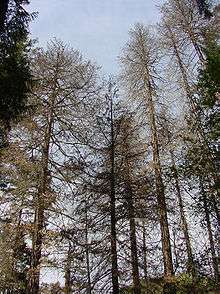Phytophthora lateralis
Phytophthora lateralis is a soil-borne plant pathogen that causes cedar root disease in Lawson cypresses (Chamaecyparis lawsoniana) in Northern USA. This pathogen was first noted to cause disease in around 1920 on nursery stock near Seattle.[1][2] Pacific yew (Taxus brevifolia) is also vulnerable to P. lateralis[3][4] but less susceptible than Lawson cypress trees, and tree mortality has only been observed in areas where C. lawsoniana trees were also infected. Asiatic species of Chamaecyparis are generally described as resistant to P. lateralis, although this pathogen is occasionally isolated from Chamaecyparis obtusa (Hinoki cypress) in nurseries.[2]
| Phytophthora lateralis | |
|---|---|
 | |
| A Port Orford cedar tree killed by Phytophthora lateralis | |
| Scientific classification | |
| Kingdom: | Chromista |
| Phylum: | Oomycota |
| Order: | Peronosporales |
| Family: | Peronosporaceae |
| Genus: | Phytophthora |
| Species: | P. lateralis |
| Binomial name | |
| Phytophthora lateralis Tucker & Milbrath, (1942) | |
Mode of infection
The most frequent symptoms of disease caused by P. lateralis are root and collar lesions. Trees become infected by their roots coming into contact with the zoospores in the soil or water. Hyphae then develop in larger roots and into the root collar where they kill the inner bark.[5] Infrequent foliar infections resulting in branch lesions, have also been reported.[6][7]
Symptoms
The foliage of infected trees initially appears slightly lighter in colour than that of healthy trees. The whole canopy turns then to pale green, yellow and then light-brown when the tree is dying. As the pathogen extends from the roots and root collar up the trunks, a sharp margin is visible between necrotic phloem, discoloured to cinnamon brown and healthy cortical tissues.
Distribution
Until recently, the known distribution area of P. lateralis was limited to Washington, Oregon, and California where it mostly occurs. In 2009, the pathogen was detected in soil of natural forests of C. obtusa in Taiwan, in agreement with a possible Asiatic origin for this species.[8] Recent outbreaks have been recorded on C. lawsoniana in France,[7] Scotland,[9] Northern Ireland, and the Netherlands.[10]
Possible risks
Since C. lawsoniana and T. brevifolia are both key components of ecosystems on the Pacific Northwest Region of North-America, P. lateralis is threatening the ecological and economical values of forests where the pathogen occurs. In Europe, where C. lawsoniana is a widespread ornamental tree, P. lateralis could represent a serious threat, especially for the ornamental plant industry if it becomes established. Because of its potential economic impact, this pathogen was added in 2006 to the A1 list of exotic species that the EPPO recommends to regulate as quarantine organisms.[11]
References
- http://www.borenv.net/BER/pdfs/ber13/ber13-A033.pdf Alien forest pathogens: Phytophthora species are changing world forests Hansen, EM Boreal Environment Research [Boreal Environ. Res.]. Vol. 13, suppl. A, pp. 33-41. 2008
- Tucker, C.M.; Milbrath, J.A., 1942: Root rot of Chamaecyparis caused by a species of Phytophthora. Mycologia 34, 94–101.
- DeNitto, G.A.; Kleijunas, J.T., 1991: First report of Phytophthora lateralis on Pacific yew. Plant Disease 75, 968.
- Murray, M.S.; Hansen, E.M., 1997: Susceptibility of Pacific Yew to Phytophthora lateralis. Plant Disease 81, 1400–1404.
- Oh, E.; Hansen, E.M., 2007: Histopathology of infection and colonization of susceptible and resistant Port-Orford-cedar by Phytophthora lateralis. Phytopathology 97, 684–693.
- Trione, E.J.; Roth, L.F., 1957: Aerial infection of Chamaecyparis by Phytophthora lateralis. Plant Disease Reporter 41, 211–215.
- Robin, C., Piou, D., Feau, N., Douzon, G., Schenck, N., Hansen, E.M. 2010. Root and aerial infections of Chamaecyparis lawsoniana by Phytophthora lateralis: a new threat for European countries. Forest Pathology, doi:10.1111/j.1439-0329.2010.00688.x
- Brasier, C.M.; Vettraino, A.M.; Chang, T.T.; Vannini, A., 2010: Phytophthora lateralis discovered in an old growth Chamaecyparis forest in Taiwan. Plant Pathology 59, 595–603.
- GB, Forestry Commission. "Phytophthora lateralis - Tree pests and diseases". www.forestry.gov.uk. Retrieved 24 June 2018.
- Sansford, C.E., 2009: Development of U.K. ⁄EU⁄EPPO Pest Risk Analyses for Phytophthora kernoviae, P. ramorum and P. lateralis. In: Phytophthora in Forests and Natural Ecosystems. Proceedings of the fourth meeting of the International Union of Forest Research Organizations (IUFRO) Working Party S07.02.09: Phytophthoras in forests and natural ecosystems. Gen. Tech. Rep. PSW-GTR-221. Ed. by Goheen, E.M.; Frankel, S.J. Albany, CA: U.S. Department of Agriculture, Forest Service, Pacific Southwest Research Station, 139–153.
- "European and Mediterranean Plant Protection Organization (EPPO)". www.eppo.org. Retrieved 24 June 2018.
External links
| Wikimedia Commons has media related to Phytophthora lateralis. |